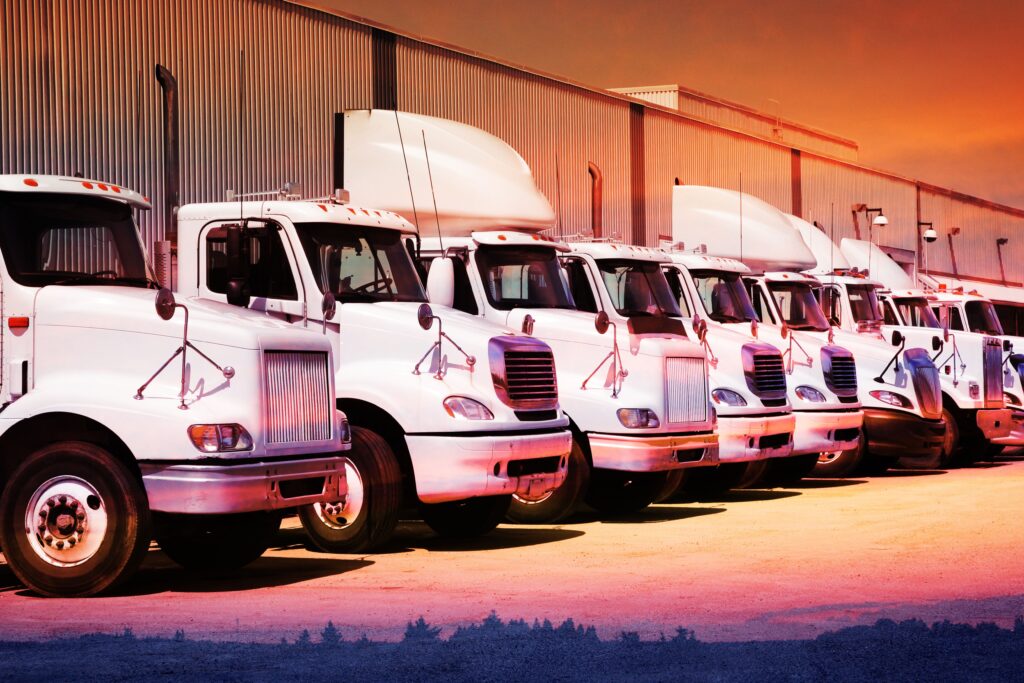The Lifeblood of Global Trade

The trucking industry is the unsung hero that keeps the wheels of global trade and commerce turning smoothly. Almost everything you lay your hands on, from that cup of morning coffee to that cozy sweater you adore, has likely spent time on a truck before reaching you.
Without trucks transporting goods across vast distances, our modern way of life would be severely hindered. In today’s interconnected world, where supply chains span continents and e-commerce dominates retail, trucking businesses play a pivotal role in ensuring the seamless movement of goods.
They serve as the vital link between manufacturers, suppliers, retailers, and ultimately consumers like you and me. From delivering raw materials to factories to transporting finished products to distribution centers or directly to stores, trucks are the backbone of logistics.
A Brief History of Trucking
To truly appreciate how far we’ve come in the world of trucking business, let’s take a nostalgic journey back in time. The humble beginnings can be traced back to the late 19th century when horse-drawn wagons were gradually replaced by steam-powered vehicles—early ancestors of modern-day trucks.
The real revolution in transportation came with the invention of gasoline-powered engines and advancements in road infrastructure during the early 20th century. This breakthrough enabled businesses to transport larger quantities at faster speeds over longer distances than ever before.
As technology improved further and highways stretched across nations like veins carrying trade and prosperity, trucking became an increasingly popular means for companies to move their goods efficiently. Over time, these once modest haulers evolved into powerful machines capable of carrying massive loads while providing comfort for drivers spending countless hours on endless roads.
This evolution paved the way for the rise of specialized trucking businesses catering to diverse industries such as agriculture, construction, logistics, and more. Looking back at this journey, it’s awe-inspiring to witness how trucking has transformed itself from a humble mode of transportation into an industry that drives economic growth and connects communities.
But the story doesn’t end here; it continues to unfold with new challenges and opportunities in an ever-changing world. So let’s delve deeper into the strategies that can help you grow your own trucking business and thrive in this dynamic landscape.
Understanding the Trucking Business Market
Analyzing Market Trends

In order to grow your trucking business, it’s crucial to have a deep understanding of the market you operate in. This involves analyzing current market trends, demands, and competition.
By studying these factors, you can gain valuable insights into how the industry is evolving and identify potential opportunities for growth. Look at statistics on freight volumes, transportation patterns, and consumer behavior to gauge demand for trucking services.
Additionally, keep a close eye on your competition – both large carriers and smaller regional players – to understand their strengths and weaknesses. This will help you identify gaps in the market that you can capitalize on.
Identifying Niche Markets
While the trucking industry as a whole is vast and competitive, there are often untapped niche markets or specialized services that present excellent opportunities for growth. Take some time to explore unique segments within the industry where your trucking business can differentiate itself from competitors.
For instance, consider focusing on transporting perishable goods requiring temperature-controlled trucks or catering to specific sectors such as automotive parts logistics or medical supply transport. By identifying these niches and tailoring your services accordingly, you can carve out a space for yourself in which competition may be less fierce while also providing specialized expertise that customers value.
Remember that success in identifying opportunities comes from thorough research coupled with creative thinking. Keep an ear to the ground by attending industry conferences or networking events where you can gain valuable insights from other players in the field.
Stay attuned to emerging trends such as e-commerce growth or sustainability efforts that may open up new avenues for your trucking business. By being proactive and adaptable in understanding market dynamics and finding untapped areas of growth within them, you’ll lay a solid foundation for expanding your trucking business.
Developing a Solid Business Plan

Setting Clear Goals
In order to grow your trucking business successfully, it is crucial to establish clear goals and objectives right from the start. These goals will serve as a roadmap, guiding your decisions and actions towards achieving sustainable growth.
Consider what you want to accomplish in terms of expansion, market share, revenue targets, or geographic reach. Be specific and measurable with your goals so that you can track progress effectively.
Conducting a Thorough SWOT Analysis
Before embarking on any growth strategy, it is essential to conduct a thorough SWOT analysis for your trucking business. SWOT stands for Strengths, Weaknesses, Opportunities, and Threats.
Evaluate the strengths of your company—what sets you apart from competitors? Identify weaknesses that might hinder growth potential and consider strategies to address them.
Explore opportunities in the market that align with your expertise or services you can offer uniquely. Be aware of potential threats like regulatory changes or economic downturns that could impact your trucking business.
Creating a Comprehensive Financial Plan
A robust financial plan is vital in growing any trucking business successfully. Start by creating a budget that encompasses all necessary expenses such as fuel costs, maintenance fees, insurance premiums, payroll expenses, and administrative overheads. This budget should be realistic but also allow room for growth investments.
Cash flow projections are crucial for monitoring incoming revenue versus outgoing expenses on a monthly basis. Develop revenue forecasts based on market research and historical data to estimate future earnings accurately.
By setting clear goals and conducting an honest assessment of strengths and weaknesses through a SWOT analysis while incorporating comprehensive financial planning into your strategy; you are better equipped to navigate the challenges inherent in growing your trucking business confidently. Note: Please remember to remove the HTML tags when using the text.
Building an Efficient Fleet of Trucks

Evaluating Different Types of Trucks
When it comes to building an efficient fleet for your trucking business, one of the crucial steps is evaluating the different types of trucks available and selecting the ones that align with your specific needs. Consider factors such as the nature of cargo you typically transport, the distance covered, and any specific requirements from your clients. For instance, if you primarily handle long-haul shipments, semi-trucks might be ideal due to their large fuel capacity and comfortable sleeping arrangements for drivers on extended journeys.
On the other hand, if you specialize in delivering oversized or heavy goods, flatbed trucks could be more suitable due to their open platform design. And don’t forget about refrigerated trucks if you plan to transport perishable goods that require temperature control.
New or Used Trucks
The decision between purchasing new or used trucks for your fleet depends on various considerations. While new vehicles offer reliability and up-to-date technology features, they tend to come with a higher price tag.
Used trucks can be a cost-effective alternative but require careful evaluation. Look for reputable dealerships or private sellers who provide detailed maintenance records and history reports for each vehicle under consideration.
Assess factors like mileage, condition of essential components (engine, brakes), and any necessary repairs or upgrades that may be needed in the near future. Additionally, weigh fuel efficiency ratings against initial costs since investing in vehicles with good mileage can save substantial amounts in the long run.
Establishing Preventive Maintenance Schedules
Maintaining a regularly scheduled preventive maintenance program is vital not only for extending the lifespan of your fleet but also for maximizing uptime and minimizing unexpected breakdowns or repairs that may disrupt operations. Create a comprehensive maintenance schedule that covers routine inspections, oil changes, tire rotations, and other essential tasks recommended by the vehicle manufacturer.
Consider partnering with a trusted mechanic or establishing an in-house maintenance team to handle minor repairs promptly. By prioritizing preventive maintenance, you can address potential issues before they become major problems that could lead to costly downtime or negatively impact your reputation as a reliable trucking service provider.
Remember, building an efficient fleet is instrumental in ensuring the smooth functioning of your trucking business. By evaluating different truck types based on your needs, making informed decisions about new or used purchases while considering costs and efficiency, and implementing a robust preventive maintenance program, you’re setting a solid foundation for growth and success in the competitive world of trucking businesses.
Hiring and Retaining Skilled Drivers

Recruiting Qualified Drivers
One of the key factors in growing a successful trucking business is having a team of skilled and reliable drivers. When it comes to recruiting drivers, it’s important to prioritize those who possess the necessary licenses and experience. Look for candidates who hold a valid commercial driver’s license (CDL) with endorsements suitable for your specific trucking business.
Additionally, consider their track record in the industry, including their driving history, accident records, and any violations. Conduct thorough background checks to ensure you are hiring drivers who can meet your company’s standards for safety and professionalism.
Providing Competitive Compensation Packages
In order to attract top-notch drivers in today’s competitive market, offering a comprehensive compensation package is crucial. Beyond just providing a fair base salary, consider including additional benefits such as health insurance coverage and retirement plans.
These benefits not only help attract experienced drivers but also contribute to employee satisfaction and loyalty over the long term. By providing these added incentives, you demonstrate your commitment to your employees’ well-being while also setting yourself apart from other trucking businesses.
Implementing Driver Retention Strategies
Retaining skilled drivers is just as important as recruiting them. To keep your best drivers engaged and motivated, it’s essential to implement effective retention strategies. One powerful way is by offering ongoing training programs that allow them to enhance their skills or learn new ones—this not only improves their job satisfaction but also contributes to overall operational efficiency.
Moreover, consider implementing performance-based incentives that reward exceptional performance or meeting predefined benchmarks such as accident-free miles or on-time deliveries. These incentive programs boost morale among your workforce while fostering healthy competition within the company.
By focusing on recruiting qualified drivers, providing competitive compensation packages, and implementing driver retention strategies, you can create a team of skilled professionals who contribute to the growth and success of your trucking business. Remember, investing in your drivers is an investment in the future of your company.
Implementing Technology Solutions for Efficiency

Utilizing GPS Tracking Systems
In this digital age, technology plays a crucial role in optimizing trucking businesses. One effective solution is the utilization of GPS tracking systems.
These nifty devices allow you to monitor your fleet’s whereabouts in real-time, providing you with accurate information on vehicle locations. By knowing where your trucks are at all times, you can effectively coordinate pickups and deliveries, ensuring timely service for your clients.
GPS tracking also enables you to identify any potential deviations from planned routes, allowing you to promptly address any issues that may arise on the road. With this technology at your fingertips, you can enhance operational efficiency and boost customer satisfaction.
Integrating Fleet Management Software
Another fantastic technological solution that can greatly benefit trucking businesses is fleet management software. This powerful tool helps streamline operations by optimizing route planning and minimizing fuel consumption. With fleet management software, you can analyze various factors such as traffic patterns, delivery schedules, and fuel prices to devise the most efficient routes for your drivers.
By selecting the shortest or least congested paths, you not only save time but also reduce fuel costs significantly. Additionally, this software provides real-time updates on road conditions and weather forecasts – invaluable information that helps drivers navigate safely while avoiding delays or hazards along their journey.
Adopting Electronic Logging Devices (ELDs)
When it comes to regulatory compliance in the trucking industry, electronic logging devices (ELDs) have become indispensable tools for trucking businesses. ELDs automatically record a driver’s hours of service (HOS), replacing traditional paper logbooks. These devices ensure compliance with HOS regulations set by governmental authorities while promoting safety and reducing fatigue-related accidents.
ELDs accurately track driving hours, rest breaks, and other essential data, eliminating the potential for errors or falsification. By adopting ELDs, you not only adhere to legal requirements but also improve operational transparency and accountability.
So, embrace this technology and keep your trucking business on the right side of the law. Implementing these technology solutions can revolutionize how trucking businesses operate – from efficient route planning to accurate tracking of vehicles and drivers’ compliance with regulations.
By harnessing GPS tracking systems, fleet management software, and electronic logging devices (ELDs), you can enhance productivity, reduce costs, and ultimately grow your trucking business. Embrace these technological advancements and stay ahead in this ever-evolving industry!
Establish Strong Relationships with Clients & Partnerships

Become a Trusted Partner
To grow your trucking business, it is crucial to establish strong relationships with clients. Building trust is the foundation of any successful partnership. Make sure to deliver excellent service consistently, meeting deadlines and exceeding expectations.
Communicate openly and transparently with your clients, keeping them informed about the progress of their shipments. By becoming a trusted partner, you will not only ensure repeat business but also gain referrals through positive word-of-mouth.
Offer Customized Solutions
Every client has unique transportation needs, so it’s essential to provide tailored solutions that align with their requirements. Take the time to understand their specific challenges and design transportation solutions that address those pain points directly. Whether it’s offering specialized equipment for delicate cargo or providing flexible delivery options, customizing your services will set you apart from competitors and strengthen your client relationships.
Provide Exceptional Customer Service
Customer service should be at the forefront of your trucking business strategy. Promptly responding to inquiries or concerns demonstrates your commitment to serving clients efficiently.
Train your customer service representatives to handle any issues with professionalism and empathy, ensuring that every interaction leaves a positive impression. Providing exceptional customer service not only improves client satisfaction but also enhances brand reputation in the trucking industry.
Conclusion
Growing a trucking business requires diligent effort in various areas such as market analysis, fleet management, driver recruitment and retention strategies, technology implementation, and establishing strong client relationships. By adopting effective strategies in these areas, you can position yourself for success in this competitive industry.
Remember that building trust with clients is paramount – strive for excellence in all aspects of your operations while continuously seeking opportunities for improvement. With determination and a well-executed plan, the future holds great potential for expanding your trucking business and achieving your goals.










